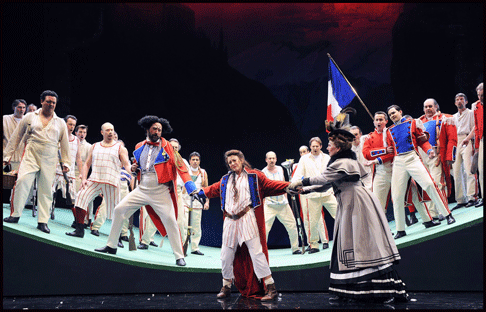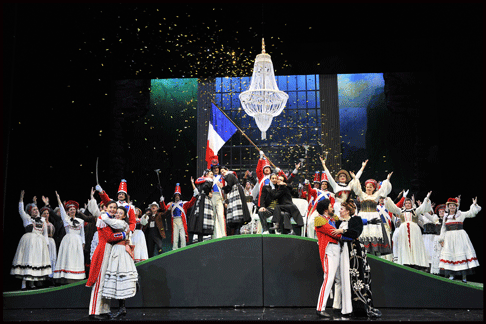17 Jan 2010
La Fille du Régiment in Montpellier
The Opéra National de Montpellier sometimes rises to artistic heights, and even when it fails its attempts are often interesting.

The Opéra National de Montpellier sometimes rises to artistic heights, and even when it fails its attempts are often interesting.
Its recent holiday offering (December 28 - January 7), Donizetti’s La Fille du Régiment directed by Davide Livermore and conducted by Jean-François Verdier, was not among these finer moments of France’s liveliest opera company.
Davide Livermore is an Italian stage director of accomplished technique well able to create a slick production, and that he did in this production originally staged at the Teatro lirico Giuseppe Verdi in Trieste, and just now remounted by Mr. Livermore in Montpellier. Unlike his superb Don Giovanni unveiled in Genova several years ago that boasted a smart concept on a brilliantly designed set, this Fille displayed an arbitrary concept in its staging on sets that seemed a textbook exercise in design.
Designer Pier Paolo Bisleri constructed a full stage platform of stolid geometric symmetry and solid color, its two halves reversing direction and splitting to offer an interior for the Berkenfeld manor and then re-reversing for the finale. That was it save for the addition of a dead center formal chandelier flanked by two very grand, very symmetrical neoclassical columns for interior scenes. Neither the platform nor the columns and chandelier responded to the pretend rusticity of the Donizetti story and the sentimental nature of its music.
The formalized setting instead was merely a platform for formalized comedy, updated commedia dell’arte in aspiration. Certainly the inclusion of a great plentitude of lazzi (little tricks incessantly performed, sight-gag after sight-gag so to speak) referred the Livermore staging to the primitive comic stage traditions that had been well surpassed by the time Donizetti was experimenting with larger contours of comedic expression.
This late Donizetti French experiment is a sophisticated spoof of nineteenth century class struggle and imperial ambitions with strongly felt sentiment in music that is meant to be above all else beautiful. Bel canto is elusive. It strives to transcend earthly realities where in fact everything is not beautiful and to escape into a musical realm where everything is.
Bel canto soars when this escape is achieved, but it is as delicate as it is elusive. It needs the hands of specialists to succeed. Instead the Montpellier Opéra placed its Fille in the hands of a novice conductor, Jean-François Verdier, a winner of conducting competitions here and there and perhaps a promising opera newcomer but with no documented previous bel canto encounters. Had the Montpellier Fille taken musical flight perhaps Mr. Livermore’s slick production would not have seemed so cold and boring.

There were some outstanding performances, notably the Duchess of Crakentorp played in drag by actor Gilles Yanetti, for once this larger than life presence in Donizetti’s comedy was in fact definitely larger than life. François Harismendy was appropriately convincing as Sulpice and Bulgarian baritone Evgueniy Alexiev was the polished servant Hortensius who labored valiantly to realize Sig. Livermore’s idea of funny antics. Swiss mezzo Hanna Shauer was over-parted as the Marquise de Berkenfeld, with neither the temperament nor voice apparent to inhabit a large comic character.
Italian soprano Monica Tarone as Marie and Argentine tenor Manuel Nuñez Camolino as Tonio made a cute romantic couple that Sig. Livermore rendered as brazen urchins, and that was fun for a while. But Marie had to work too hard to keep it up and we soon tired of her personality. Both Madamoiselle Tarone and Mr. Camolino are accomplished singers. We were deprived however of the pleasures of bel canto in their extended duets and arias maybe by the inexperience in the pit, perhaps by the over-wrought comic processes on the stage, more probably by their roles begging for more nuanced singers.

Stage colors were primary, with lots of white in the soldiers’ costumes. The lighting, attributed to Mr. Livermore, was striking indeed, popping the characters out into high visual relief and sculpting the chandelier and bas-relief columns in quite beautiful, impeccably balanced stage pictures. Theater artifice seemed Mr. Livermore’s primary objective. His staged tableaus flashed during the overture, with firecrackers precisely timed to the music, promised charm and fun. Neither materialized. And finally the Opéra National de Montpellier simply did not provide sufficient musical and vocal resources to salvage Donizetti’s mid-nineteenth century social comedy.
Michael Milenski